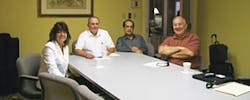AMTSociety Mx Logs Update
Aviation Maintenance Technician Awards Program
The FAA/Industry AMT Committee convened in Nashville, TN, July 8 to 10 for the purpose of rewriting Advisory Circular 65-25D for the program.
Committee members are Tom Hendershot, chairman; Jennnifer C. Baker, secretary, president of Baker’s School of Aeronautics, Nashville, TN; Hasnain Ansari, vice president of aircraft maintenance for Swissport Aircraft Maintenance, Los Angeles, CA; Gary Goodpaster, chief of maintenance, Kroger Company, Cincinnati, OH; Fred Mirgle, chairman, Charles E. Taylor Department of Aviation Maintenance Science, Embry-Riddle Aeronautical University, Daytona Beach, FL; and Phil Randall, Deputy National FAASTeam manager.
After two and one-half days of review, discussion, analysis, and proofreading, the revised draft was sent to Washington, D.C., to AFS-300. The beta test will start on Oct. 1, 2008. The date for implementing the new items is Jan. 1, 2009.
Perhaps the biggest change is that each aviation maintenance technician will need to go into the program electronically and must be registered on the FAASafety.gov website. There are many more enhancements, and they will be available from the FAASafety.gov information.
All training completed during the period of time from Jan. 1 through Dec. 31 will be eligible for an individual award for that year.
Training will focus on aviation maintenance accident/incident causal factors, special emphasis items, and regulatory issues deemed necessary by AFS-300.
Perfect Landing continues industry support
Jim and Sean Carter, owners of the Perfect Landing Restaurant located at Centennial Airport in Englewood, CO, are shown hanging a copy of the House of Representatives House Resolution Number 444 “National Aviation Maintenance Technician Day” in their award-winning restaurant.
Jim and Sean have been catering to aviation and business professionals since 1992. The Perfect Landing has placed in the top four of the Professional Pilot Catering Survey for the past 17 years. The restaurant also is home to numerous trophies representing local pilots who have been involved in the Reno Air Races.
Continuing its commitment and support of the aviation industry and the community, July 16 to Sept. 10, 2008, the Perfect Landing will serve a complementary breakfast, lunch, or dinner with a paid flight reservation in the only B-25H Barbie III flying today. It is operated by Warbird Unlimited Foundation Inc. Educational Foundation, Mesa, AZ.
The B-25H named “Barbie III” will be based at Denver Jet Center at Centennial Airport in Denver. The famous medium bomber is fully restored to 1943 standards, and will be available for free viewing on the ground on Saturdays and Sundays through the second week of September.
It is available for 30-minute flights around Denver. Flights are a $375 donation per person, per flight, with room for up to six people each flight. The donation goes into defraying the operating expenses and helps pay for maintenance and upkeep.
The B-25 Mitchell is best known for its role in the famous Doolittle raid on Japan in 1942, where 16 B-25s flew from the aircraft carrier USS Hornet to make the first attack on Japan following the Pearl Harbor attack. Throughout WWII, the B-25 played a major role as a medium bomber and ground attack aircraft in both the Pacific and European Theater of operations.
More than 9,800 B-25s were built from 1940 to 1945, but only around 30 remain in flying condition. Out of those remaining, this B-25, the “Barbie III”, is the last flying H-model of the B-25-.
Maintenance brotherhood
In late July an aircraft maintenance technician at American Airlines in Dallas/Fort Worth died in a motorcycle crash. Steve Stevens was loved by all and I am told he was “one of the good guys” meaning that he was truly liked by everyone he met. He was also a good mechanic.
His remains were flown back to Columbus, OH. Steve was not married and he did not have any children. The aircraft left out of gate C8 and it was surrounded by a couple hundred AMTs, management, and secretaries. After the casket was loaded onto the aircraft by his friends, fellow mechanics then split up and formed two lines, and “walked” the aircraft off the gate.
As the engines started the two lines of AMTs stretched out to form a corridor all the way to the taxiway. The aircraft taxied away. As it did, the Captain opened his window and waved to everyone. By now all the passengers were all waving out the windows. As the aircraft reached the beginning of the taxiway there were two fire trucks waiting and they gave a water-cannon salute.
This was all done because Steve belonged to a proud craft and profession where regardless of the uniform you wear we are all the same: craftsmen.
— Ken MacTiernan
